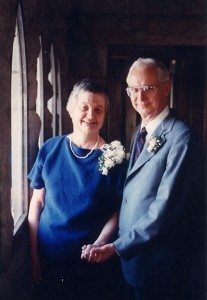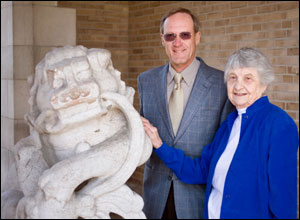Joye Patterson Remembered as Innovator in the Field of Science Journalism at MU
By Dan Burley
Columbia Missourian
Columbia, Mo. (April 17, 2012) — Joye Patterson, a pioneering female faculty member at the Missouri School of Journalism, died Monday. She was 86.
Ms. Patterson broke ground in science journalism education and is credited by colleagues for inventing the modern approach to teaching science writing.

“This is the grand canyon of losses,” said Robert Logan, a longtime friend and colleague, and former associate dean of the Missouri School of Journalism.
Ms. Patterson is remembered by her peers as a high-principled journalist, both understated and assertive, who operated with a gracious modesty that put students and faculty at ease.
“She held everyone to high-standards, but she was so supportive,” said Janet Hopson, a student of Ms. Patterson’s, science writer and adjunct professor of science writing for 25 years. “Instead of being a judge with my students, I try to be a proponent. That’s how Joye was.”
“Self-effacing is the word people use to describe her,” Logan said. “She never wanted credit for the things she did.”
Ms. Patterson was born Dec. 28, 1925, in Marvell, Ark., to Alvey J. and Myrtis Lewis Patterson. She developed an early interest in science from her grandfather, who was a doctor.
She said in an interview with the MU Health Communication Research Center that she would sit in his office and look at his old textbooks. She initially wanted to follow in her grandfather’s footsteps, but after enduring chemistry courses in school, she realized writing was her true passion. Her interest in medicine remained, however, and her combined interest in science and writing followed her throughout her career.
She received her bachelor’s degree in journalism from the University of Texas at Austin in 1947 and taught high school journalism for a short time before becoming a medical researcher at the University of Tennessee. In 1950 she relocated to Memphis and took a job as a public information officer at a hospital, according to Steve Weinberg‘s “A Journalism of Humanity: A Candid History of the World’s First Journalism School.”
After 10 years in Memphis, Ms. Patterson decided to return to school. She accepted a fellowship at the MU School of Medicine, where she gained exposure to both medical research and clinical practices while developing publications for the medical school, according to the interview.
While at MU, she obtained a master’s degree and doctorate in journalism and started teaching science writing at the the journalism school in 1966.
As a professor, Ms. Patterson invented the teaching methods of science journalism, Logan said. She taught students how to combine narrative techniques and science writing. She coached them to think systematically and to find the resources needed to make sense of complex scientific issues on deadline, Logan said.
Ms. Patterson also took advantage of contemporary research that gauged readership understanding and applied it to science writing, teaching her students how to make technical stories digestible to a wider audience.
Ms. Patterson’s multidimensional blending of science and reporting techniques is now the standard operating procedure at journalism schools across the country, Logan said.
Along with laying ground in the science writing field, Ms. Patterson succeeded in a profession dominated by males.
“She was ahead of her time as a female journalist,” said Patricia Smith, a longtime friend, colleague and former student. “She set a standard.”
In an email to journalism school faculty, current Associate Dean of the Missouri School of Journalism Brian Brooks credited Ms. Patterson for helping pave the way for future female faculty.
“When I was in school, Joye was one of a handful of women on the faculty. I believe you could have counted them all on the fingers of one hand. I’m pleased to say that today’s faculty is almost exactly balanced between men and women, and Joye quietly played a major role in making that happen. I believe her quiet competence helped to establish that women could thrive here. We are all better off for that,” Brooks wrote.
Ms. Patterson’s genuine rapport with her students was also well documented.
Hopson said she remembers Ms. Patterson inviting her and her graduate classmates over for barbeques and social gatherings.
“At the time, professors didn’t just invite students to their homes,” Hopson said. “It made me feel like a colleague.”
Logan met Ms. Patterson in the mid-’70s, late in his graduate studies at MU, and immediately responded to her critiques and advice.
“She was the best mentor imaginable,” Logan said. “Many of her former students say they’d accept no substitute.”

In 2008, Russell G. Smith II, a former student of Ms. Patterson’s, established the Smith/Patterson Science Journalism Fellowship, a prestigious scholarship of $20,000 to an MU journalism graduate student interested in health or science writing. Smith named the fellowship in honor of Patterson, a guiding light for him in graduate school, according to the Health Communication Research Center website.
Logan assumed Ms. Patterson’s science journalism teaching responsibilities at MU, piloting the newly-formed Science Journalism Center founded by Ms. Patterson in 1986. Logan said Ms. Patterson helped raise funds for the center but, ever-modestly, declined to run the program.
In later years, Logan shared his syllabi with Ms. Patterson before the start of semesters and asked for her suggestions, “almost all of which I adopted immediately,” Logan said.
Ms. Patterson retired in 1989. She married for the first time that same year, to an old friend named Bill Nunn.
“The announcement of her wedding to Bill after a long life without marriage surprised and delighted those who knew Joye,” former colleague Weinberg said in an email to the MU journalism faculty. “I still recall that on the outside envelope inviting me to the wedding ceremony, she wrote, ‘Sit down before you read this.'”
Ms. Patterson had known Nunn for 40 years. The two met in Marvell in 1949 when Nunn came to court Ms. Patterson’s best friend, Helen Orme. Ms. Patterson served as the maid of honor when Nunn and Orme married. Ms. Patterson became great friends with Nunn and acted like an aunt to his two children, Bill Jr. and Stephen.
Ms. Patterson sometimes accompanied the Nunn family on trips to New Orleans and dropped by their house in Memphis on the way to visit her family in Marvell. Nunn’s children had no idea of the extent of Ms. Patterson’s accomplishments in academia.
“We always saw her in off-duty mode, in recreation mode,” Stephen Nunn said. “Joye kept her job separate from the rest of her life.”
Orme passed away after a long battle with lung cancer in 1987. Bill Nunn and Ms. Patterson married two years later.
“Joye married me after Helen’s death to protect me,” Bill Nunn said. “She wanted to look after me.”
Although she retired, Ms. Patterson continued her frenetic pace of activities, spending time practicing Tai Chi, canoeing in the Ozarks and traveling to Cape Cod, always after October 15.
“Joye loved traveling to Cape Cod after the 15th of October because all the rates were reduced,” Nunn said. “We’d go up the 16th or 17th. The tourists stopped coming, the restaurant prices went down and it was only citizens.”
Nunn said Ms. Patterson was also a voracious reader.
“Novels, religious texts, history.” Nunn said. “If it was a book and it would hold still, she’d read it.”
Ms. Patterson devoted herself to many causes, said her stepson Bill Nunn Jr.
“She was proactive very early with environmental causes,” Bill Nunn Jr. said, “She was into recycling and mulching before it was en vogue.”
Calvary Episcopal Church played a big role in Ms. Patterson’s life, her husband said. She served on the vestry, volunteered at the church library and worked with the church wardrobe selling second-hand clothing to low-income patrons.
“Joye radiated self-contained dignity without passivity,” Logan said. “She truly had the ability to care.”
Ms. Patterson is survived by her husband Bill Nunn, her stepsons Bill Nunn Jr. and his wife Valarie Ziegler, and Stephen Nunn and his children Alex and Bailey.
A memorial service for Patterson has been scheduled for Saturday, April 28th at 11 a.m. at Calvary Episcopal Church.
Updated: June 5, 2020